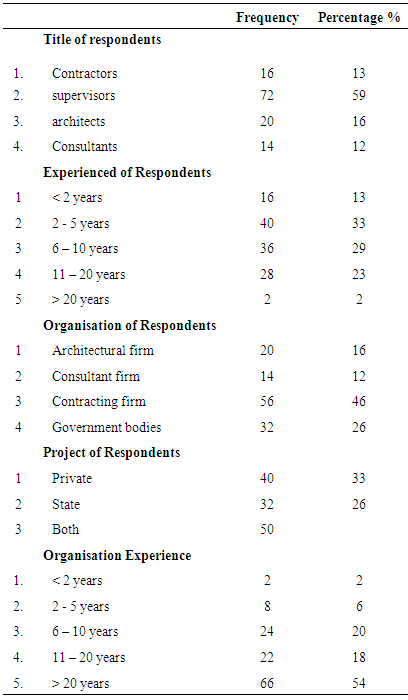-
Paper Information
- Next Paper
- Paper Submission
-
Journal Information
- About This Journal
- Editorial Board
- Current Issue
- Archive
- Author Guidelines
- Contact Us
International Journal of Construction Engineering and Management
p-ISSN: 2326-1080 e-ISSN: 2326-1102
2015; 4(1): 13-25
doi:10.5923/j.ijcem.20150401.02
Integration of Sustainable Construction in Project Management: A Case Study in Ghana
Charles Atombo1, Joseph Cudjoe Kwedza Dzantor2, Aaron Agbenyegah Agbo3
1Department of Mechanical Engineering, Ho Polytechnic, Volta Region, Ghana
2Department of Building and Civil Engineering, Ho Polytechnic, Volta Region, Ghana
3School of Logistics Engineering, Wuhan University of Technology, Wuhan City, China
Correspondence to: Charles Atombo, Department of Mechanical Engineering, Ho Polytechnic, Volta Region, Ghana.
| Email: |  |
Copyright © 2015 Scientific & Academic Publishing. All Rights Reserved.
The increase in human population requires more buildings that require more use of resources. This trend has a negative impact on the natural environment, economic and social issues, affecting the quality of life of current and future generations. This study reports the views of construction experts on the incorporation of sustainable construction in project management in Ghana. In all, data were collected from 122 construction professionals selected randomly by survey. At different stages, site, water, waste, energy, human and material factors were used. The study indicated that perceptions of project success when it runs within the triple goals (time, cost and quality) are influencing construction professionals to undermine the involvement of sustainability benefits (environmental, economic and social) in terms of the criteria used to measure the project's success. However, most of the building structures in Ghana depend largely on the energy, increases energy waste reducing occupant comfort. The result also showed that recycled construction materials are not fully used in buildings, and this is as a result of unavailability in the industry, uncompetitive price of the product and lack of incentives for the use of such materials. The study concludes that, the challenge the construction industry is facing today is not only to complete projects within time, cost and quality, but to integrate various constraints such as economic, environmental and social needs in the act of building.
Keywords: Sustainable Construction, Green Building, Sustainable Building, Waste, Project Management, Environment, Social, Economic
Cite this paper: Charles Atombo, Joseph Cudjoe Kwedza Dzantor, Aaron Agbenyegah Agbo, Integration of Sustainable Construction in Project Management: A Case Study in Ghana, International Journal of Construction Engineering and Management , Vol. 4 No. 1, 2015, pp. 13-25. doi: 10.5923/j.ijcem.20150401.02.
Article Outline
1. Introduction
- World Commission on Environment and Development [1] defines sustainable construction as an idea of ensuring a better quality of life for every person, now and for future generations by means of achieving social, economic and environmental objective at the same time. The state of the environment is a matter of growing concern [2]. It is a concern based on the observation that waste generated in the environment is already affecting the quality of life of people throughout the world.The increase in population increases the need for more buildings, houses, and infrastructure [3]. This calls for more utilisation of resources such as water, land, energy and air thus increasing the amount of waste generated by the whole life cycle of building project. Moreover, parallel to rapid urbanisation and increase number of buildings in Ghana, the environmental footprint of construction activities will create an extensive amount of waste and this will increasingly become a major issue in urban waste management. According to Yahya and Boussabaine [4] the main causes of waste generation could include errors in contract documents, changes to design, materials ordering errors, accidents, lack of site control, lack of waste management, and damage during transportation.The construction sector is reported to be generating unacceptable levels of waste than what our environment can absorb [5] which Ghana is no exception. This situation could be attributed to poor planning during the life cycle of construction projects in Ghana. UNEP [6] revealed that increased construction activities and urbanisation will increase waste which will eventually destroy natural resources and wild life habitats over 70% of land surface from now up to 2032. Building projects have significant impact on the environment, contributing for one-sixth of the world’s fresh water, one-quarter of the wood harvest and two- fifth of it materials and energy [7] thus making construction sector one of the activities influencing climate change the most [8]. The Ghanaian Government spends a lot of money to manage waste generated in the environment. A well planned and designed project considers the natural environment and confirms its importance and our well-being. For these reasons, many aspects such as environmental, economic and social benefits in terms of the standards used to measure project success needs to be integrated.Waste minimisation is identified as one of the key factors for achieving sustainability [9]. There is an urgent need for the society to reduce the production of waste, minimise the use of resources and energy and enhance the efficiency of its processes. Issues like day lighting, natural ventilation, and sun protection, environmental comfort and energy efficiency must be addressed in the first stages of the building design in order to achieve sustainable and efficient buildings. In the construction industry the most important phase is the design phase because, good or poor design can affect the whole life cycle of the construction [10]. Miyatake [11] has suggested three techniques for achieving sustainable construction such as creating a built environment for a better quality of life, restoring damaged or polluted environments and improving damaged environments. To achieve sustainable construction, the industry must increase the use of recycled, renewed and reused resources, and decrease in significant use of energy and other natural resources.To overcome these problems emanating from the construction industry a successful project execution that promotes better quality of life for every one now and for future generations must be pivoted not only on the triple constrain of project (cost, time and quality) but also include sustainability balance issues (social, economic and environmental) by the incorporation of sustainable construction technique in building at the design stage.
1.1. Sustainable Construction
- The term sustainable construction refers to the process of constructing a structure that is environmentally sound and resource-efficient throughout the buildings life [12]. Sustainable construction incorporates a recyclable aspect throughout the building’s lifecycle, in terms of resources used and the impact it poses on the environment from design to construction and subsequent operation, maintenance, renovation and finally its demolition. According to Malik et al, [13] Sustainable construction could be best defined as the creation of a healthy built environment based on resource efficiency and ecological principles. Therefore, sustainable construction could also be described as a subset of sustainable development, which includes design, tendering, site planning, and organisation, material selection, recycling, and waste minimisation [14].The CIB suggested seven principles of sustainable construction which informs decision makers during each stage of the design which are: reducing resource consumption; reusing resources; using recyclable resources; protection nature; eliminating toxics; applying life-cycle costing; and emphasising quality [15].To obtain solutions to present construction and infrastructure problems, it is important to consider environmental, social, and economic aspects, their synergies and the inevitable balances between them. Sustainability in this way expresses solutions with regard to a whole system. Creating better-built environments for human lives is one of the objectives of sustainable construction. However, in order to achieve this objective, there is a need to pay attention to sustainability techniques to make sure our built environment lasts for the next century and beyond. One of the methods to use is changing the linear construction process to a cyclical process as it increases the use of recycled, renewed and reused resources [13].Nowadays, civil engineers play important roles to achieve a direct and high level of contributions to realise a sustainable society. Sustainable construction also involves considering the entire life cycle of the building, taking environmental and functional quality, and future values into consideration. Besides that, sustainable construction also involves creating buildings that allow user to continue enjoying the standards of living we experience today, while at the same time ensuring that future generations will have access to the goods and services needed for their survival [16]. It focuses on minimising waste production, minimising energy consumption, preserving and enhancing, conserving water resources and respecting people and the environment [16].
 | Figure 1. Themes of Sustainable Development [13] |
- It can be stated that, to achieve successful building projects does not only depend on completing within time, cost and quality but taking into consideration the integration of sustainability (social, environmental and economic) aspects.
1.2. Sustainable or Green Building
- Sustainable building is the design and construction of buildings using methods and materials that are resource efficient and that will not compromise the associated health and well-being of the building’s occupants, construction workers, and future generations. Sustainable building involves the consideration of many factors, including site impacts, land use, indoor environment, energy and water use, lifecycle impact of building materials, and solid waste. Building “green,” or building with environmental considerations in mind, is one important factor of the overall concept of sustainable design. Conventional building practices often overlook the interrelationships between a building, its components, surroundings, and occupants. Buildings consume more resources, undesirably impact the environment, and create a huge amount of waste. These buildings are often costly to operate in terms of energy and water consumption [17] and they could result in poor indoor air quality, which can lead to health problems. Sustainable building practices offer an opportunity to create environmentally sound and resource-efficient building by using an integrated approach to design. Green buildings consider environmental effects and waste reduction, build a healthy and comfortable environment, and reduce operation and maintenance costs. The design and the components of the building are considered, as well as the economic, environmental impact and performance. Sustainable building designs and strategies are ultimately about resource efficiency and can be incorporated in every building project within the Ghanaian context.
1.3. Benefits of Sustainable Construction
- According to Ashe [18], achieving sustainable design will produce buildings: with lower embodied energy and harmful emissions; using reusable, renewable, recyclable and reparable resources; and using water and energy more efficiently. It will increase the demand of practitioners (buildings, designers, consultants etc.) and increase marketing and promotional opportunities associated with sustainable building.By integrating sustainable construction technique in project management there are a number of environmental, social, and economic benefits to achieve. These include:● Environmental benefits in the improvement of air and water quality, minimisation of energy and water consumption and reduction of waste disposal, climate stabilisation, ozone layer protection, natural resource conservation, open space, habitat and biodiversity protection [19].● Economic benefits are reducing operating and maintenance cost and increasing revenue (sale price or rent); energy efficient and conservation of resources and materials [20].● Social benefits are enhancing occupant comfort and health and reduce liability [21].By referring to the Luther [16], there is only one disadvantage in integrating sustainable construction. Sustainable buildings have a higher initial cost than ordinary building. Not every project gets overall net increased cost in a short period. To cover these problems, life analysis cost has to be conducted to account for reduction of operating cost. There are several barriers causing the slow application of sustainable construction in the industry. The barriers include lack of relevant skill and knowledge and others. Some benefits such as improving occupant health, comfort, and productivity, reducing pollutant and landfill waste are not easily quantified.Sustainable buildings are designed with a special emphasis on waste prevention and the use of recycled-content products. Renovation and deconstruction are done in a manner that reduces solid waste and captures significant cost savings. Buildings with access to day lighting decrease demand for fossil fuel for lighting and heating, thereby lowering energy wasting [22]. However, it is important to design day lighting carefully so that it does not create greater need for air conditioning for cooling.
|
1.4. Sustainable Design
- According to Malik et al, [13], sustainable design solutions to technical problems takes into account the minimisation of cost, conservation of energy and natural materials, reduction of pollution and increased comfort.Sustainable design can be defined as integration of architecture with electrical works, mechanical and structural works. Sustainable design also means conception and realisation of environmentally sensitive and responsible expression as part of involving matrix of nature [23].When designing a sustainable building, probably the most important aspect will be the materials used within the construction. Ultimately the materials used will determine the building’s sustainable performance. Using reclaimed materials such as wood, bricks or metals can reduce carbon emissions produced during the construction of new buildings. By recycling materials in this way means less energy is needed to produce new materials therefore cutting down the emissions produced by each house built using reclaimed materials. Using green building materials is one of two fundamental material conservation strategies to be noted at the design phase for buildings [24]
2. Methodology
2.1. Study Area
- The study was conducted in three regional cities in Ghana where there are a lot of construction activities. There are many construction industries in the selected cities because of the need for more buildings, houses, and infrastructure due to growing population in these cities. As a result, there is more utilisation of resources such as water, land, energy and air thus increasing the amount of waste generated by the whole life cycle of building project within these selected cities. Building projects such as state and private were the type considered.
2.2. Data Collection Technique
- A multi-approach was adopted for data collection to integrate the strengths of each technique. This involved survey method and interviews with the questionnaire as guide to the respondents in the construction industry. These methods of data collection have no advantage over other and are highly complementary. This approach was chosen to increase the validity and scope of the data collection techniques, depth and knowledge of the collected data. A pre-testing questionnaire was administered to construction experts in the construction industries identified to add, remove, criticise and justify responses for validation purposes. The pre-test allowed for the fine tuning of the drafted questionnaire to remove any ambiguity. The process helped the researchers to know whether the respondents understood the questions and could give useful answers and also to determine the feasibility of the data gathering exercise
2.2.1. Survey
- Refined written and printed questionnaires comprising a series of structured questions were administered directly to a number of construction experts with various backgrounds identified to obtain data for the study. The purpose of the process was to gain information about construction expert’s point of view regarding issues of sustainability in building projects. The questionnaires were divided into 4 sections based on the specific objectives. The likert scale was used to present the answer from the respondents in the form as follows; strongly disagree = 1, Disagree =2, Neutral = 3, Agree =4, strongly agree = 5. The first step had response from the professionals in the sampled industries. The Second step had responses from academia directly involved in this research.
2.3. Sampling
- The minimum statistically acceptable sampling size of 122 was conveniently selected using the Kish method [25] to justify the responsive sample size of the survey that represented the target population as precisely as needed. The respondents were selected randomly which included academia, state and private construction professionals into buildings to gain information about their point of view with issues of sustainable building projects in Ghana.The sample size was calculated using the following equation:
 Where:n = sample size N = total population
Where:n = sample size N = total population  E = Maximum allowable error of sampling distributionS = maximum standard deviation of an estimate of the population element.S2 = p*(1- p)P = proportion of population elements belonging to the defined class.Using a total error of 0.05 at 95% confidence level, E = 0.025 and p = 0.5;
E = Maximum allowable error of sampling distributionS = maximum standard deviation of an estimate of the population element.S2 = p*(1- p)P = proportion of population elements belonging to the defined class.Using a total error of 0.05 at 95% confidence level, E = 0.025 and p = 0.5; The total population value (N) of 175,
The total population value (N) of 175,  Hence:
Hence:  n = 122Therefore minimum sampling size for the survey = 122
n = 122Therefore minimum sampling size for the survey = 1222.4. Data Presentation and Analysis
- The data was edited, coded and entered into a computer equipped with the Statistical Package for Social Scientists (SPSS) version 16. Data was presented and organised into tables and bar charts using Microsoft Excel. All the collected data were analysed in two ways: these took the form of frequency and average index analysis. Frequency analysis was used as preliminary analysis to show the frequency and the percentage. The average index used likert scale of five ordinal measures of agreement ranging from strongly disagree (1) to strongly agree (5) to present the responses from the respondents. The average index was calculated based on the formula as follows [26]:
 Where:αi - Constant expressing the weight given to ixi - Variable expressing the frequency of the response for i = 1, 2,3,4,5
Where:αi - Constant expressing the weight given to ixi - Variable expressing the frequency of the response for i = 1, 2,3,4,5 3. Results
3.1. Demographic Characteristics of Respondents
- The respondents were divided into four categories; Contractors, supervisors, architects, and consultants. The demographic characteristics of respondents showed that majority of the respondents (59%) were supervisors. This was because at every unit in the contracting firm there were one or two supervisors. Most of the respondents had experience between 2-5 years with the least number of respondents having rich experience of more than 20 years (Table 2). In addition the respondents represent different organizations with most of them working in the contracting firms (46%). This may be because more labour is required in this sector. In Ghana government, workers are allowed to do other private jobs at leisure time. The table further indicates that several respondents (41%) deal with both state and private projects. From the survey, the majority of the respondents (54%) belonged to companies that had experience more than 20 years. This was followed by companies with experience of 6-10 years and 11-20 years with percentage of (20%) and (18%) respectively in the construction industry.
|
3.2. Basic Knowledge about Sustainable Construction and Development
- This part focuses on the basic knowledge of each respondent about the sustainable construction. The respondents answered a total of 5 questions (fig 2) according to their understanding of what sustainable construction meant and their needs. Policy to be instituted to monitor sustainable construction practice in construction industry and applying sustainable construction policies in construction industry to reduce the waste generated in the environment to improve life being were deemed to be the most important consideration although all the criteria were given almost the same level of importance.
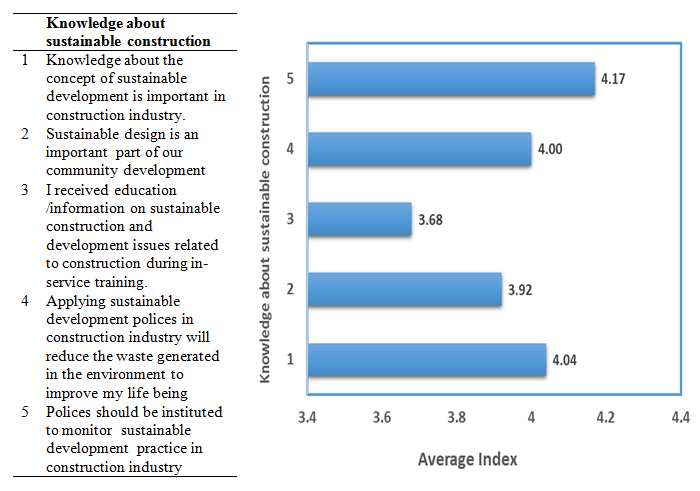 | Figure 2. Knowledge of sustainable construction |
3.3. Pre-design Phase
- The pre-design phase is an important stage in construction process. Many things need to be considered during this phase, as it is a critical stage that shapes the eventual design and development of a sustainable building. It is clear that the 7 sustainable techniques related to pre-design phase (Fig. 3) were all ranked as being very important. The most important of these considerations to be integrated are community, regions, 'sense of place' and heritage, equity and human rights and long term economic health. In addition, the respondents agreed that the settlement efficiency and quality of life and accountability, transparency, and engagement are unique techniques relevant to sustainable building.
 | Figure 3. Sustainable Technique in Pre-design Phase |
3.4. Design Phase
- The design process on all projects follows the same stages of development. In design phase, it is important to implement the sustainability issue to reduce waste. The below fig 4 illustrates that the equity and human right accountability, transparency and engagement were deemed to be extremely significant technique to be integrated in Ghanaian buildings. Besides that, the respondents agreed that the rest of the techniques were also highly important criteria to be taken into consideration to achieve sustainable building projects.
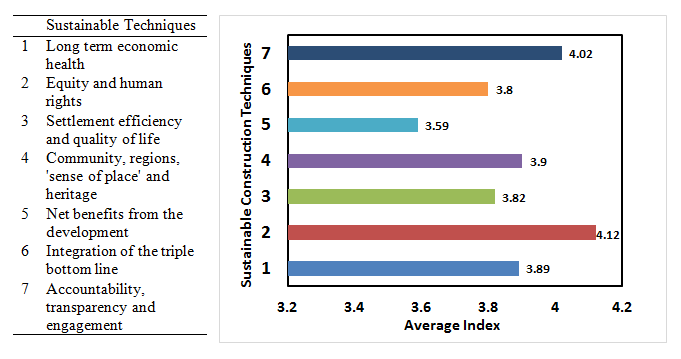 | Figure 4. Sustainable Technique in Design phase |
3.5. Construction Phase
- The construction phase is a critical stage that the sustainable issues should be of great concern, because during this phase there are many activities that can give impact to the generation of waste. It is evident that (Fig 5) the settlement efficiency and quality of life is rated highest important technique to achieve sustainability.
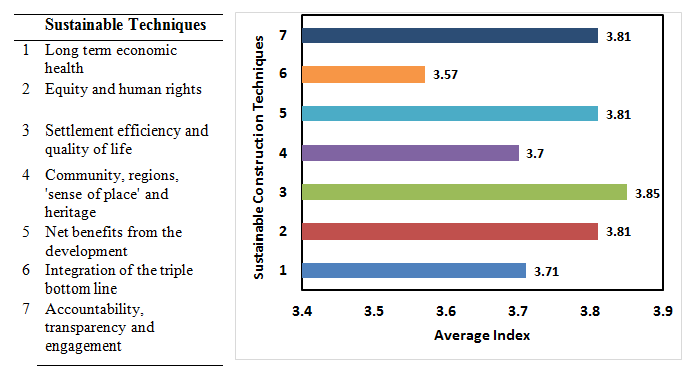 | Figure 5. Sustainable Construction Technique in Construction phase |
3.6. Materials Efficiency
- Fig 6 illustrates the suitable practices in term of choice of material for sustainable building to reduce waste at the design stage. It is evident in the figure that, materials were selected based on their durability. Use of locally available or naturally materials in preference to those imported long distances and Materials selected based on analyses of their lifecycle impacts on public health were the most important considerations. The experts also agreed that preparing a green building product selection plan and the use of salvage building product were also ranked the same level of importance in the criteria in the Ghanaian context.The figure further showed that, use of recycled content building products and material, use of rapidly materials from renewable resources and use of materials that are reusable, recyclable or biodegradable were slightly considered as important criteria.
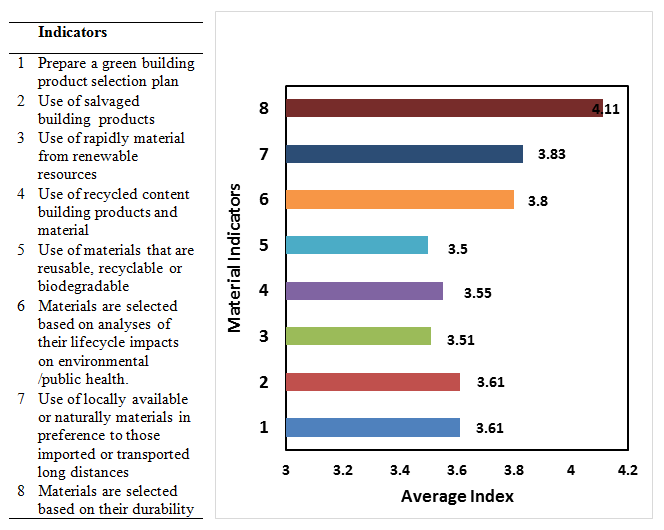 | Figure 6. Material efficiency |
3.7. Analysis of Design due to the Site
- Creating sustainable construction starts with proper site selection. Careful planning, building orientation, and landscaping can cut energy consumption levels. Hence, the responses to the indicators below (Fig 7) do not encourage achieving sustainable building; apart from conducting a comprehensive site assessment which is within the acceptable average index, the rest of the indicators scored less than 3.50 of the acceptable average index.
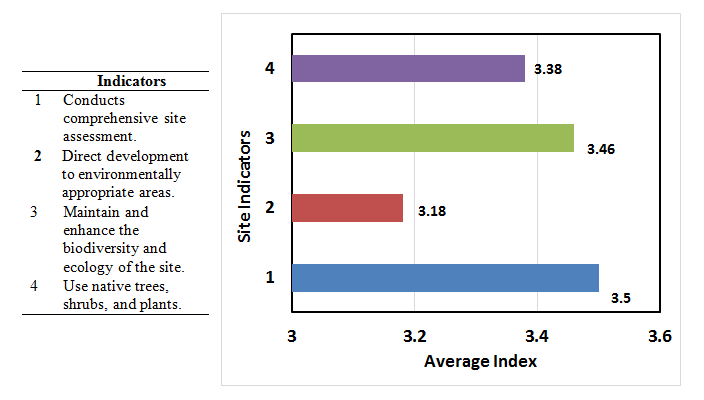 | Figure 7. Ranking of Site Indicators |
3.8. Water Efficiency
- Water is one of the limit resources that should be used efficiently indoors and outdoors. In order to achieve the sustainable construction, the overall consumption of water must be reduced. It is clear from the water efficiency indicator (Fig. 8) that, use of biological waste treatment and measures that maximised the harvest of rain water for use were deemed to be the highest significant for achieving sustainable building. Furthermore, water conservation measures had to be incorporated into the design, conserve building water and cooling tower water consumption, water saving toilets with differentiated flush installed were also indicated as important ways of reducing water consumption.
 | Figure 8. Water efficiency |
3.9. Energy Efficiency
- Energy is the area which the professionals needed to show best concern to make life in certain locations sustainably developed to reduce waste in building projects at the design stages. The indicators set out in Fig. 9, indicate that the use of energy source with low environmental effects and the use of efficient equipment and appliances were ranked the highest significant indicator. The respondents also rated the rest of the energy indicators below the acceptable average index and this is not encouraging in achieving sustainability.
 | Figure 9. The energy efficiency |
3.10. Human Factor
- Human factors play an important role to provide a good design in construction work. All consumers on the planet spend almost all their time in an artificial environment, the performance of this environment in terms of its sustainability is one of the major concerns for the preservation of the world. Fig 10 indicates that providing effective lighting during the design process and providing view space and connection to the natural environment were considered of the highest importance, in addition to the measures to protect in door quality. The provision of appropriate building acoustic and vibration conditions was also a core consideration.
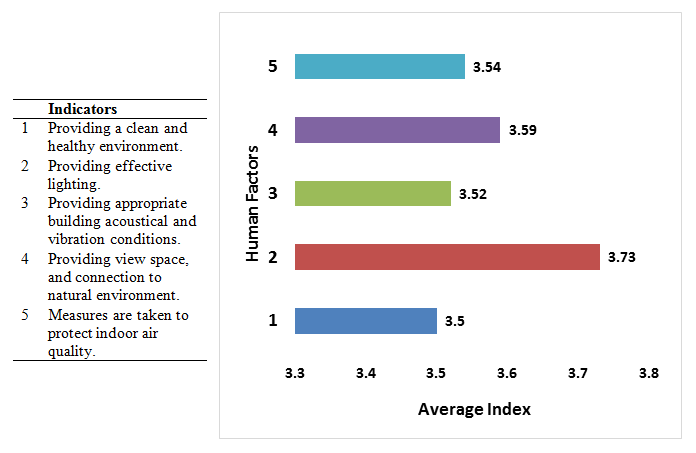 | Figure 10. Human factors |
3.11. Waste Management
- The construction process itself generates significant quantities of waste at every stage. Minimising waste, promoting environmentally sound waste, reuse and recycling are matters of great concern to the construction industry. Construction and demolition activities produce large quantities of waste, increasing the amount that is currently recycled and reused. The waste management indicators (Fig. 11) indicate that integration of reduced and recycled construction waste and adaptations of rehabilitated existing buildings at the design stage were rated the highest important indicators. This was followed by design of buildings for adaptability and disassembly, although design for less material use and preparation and implementation of construction waste reduction plan were ranked almost at the same level of importance.
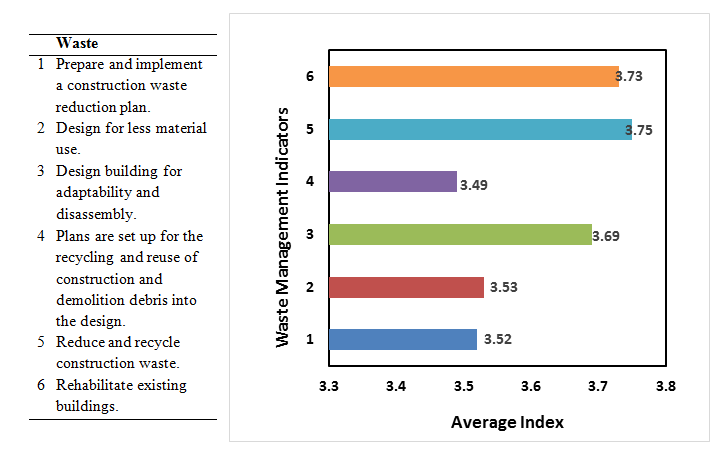 | Figure 11. Waste Management |
4. Discussion
- Ekanayake and Ofori [5] indicated that, waste generation from construction activities continues to become a problem in developing countries as long as the integration of sustainable construction in project management is not embraced at the design stage. There is therefore the need to recommend modalities to minimise this problem in project management. The concept of sustainability is not fully understood and implemented thus generating unbearable waste in our environment affecting quality of life.More of the construction professionals were supervisors and given more education and in- service training on the importance of the sustainability of building projects, will help improve sustainability providing a healthy environment. These groups of professional should be involved at the design stage. Wong et al [27] confirm that awareness of integration of sustainable construction in building at the earliest design stage would help increase the possibility of putting up more sustainable buildings that would reduce delays, waste from water, energy, material, and land to minimise financial costs.Knowledge about the concepts of sustainable construction is a matter of concern and that sustainability issues are important as part of our community development. The construction professionals are practicing sustainable construction but it significance is not known. It can be realised by exposing the professionals to the importance of this concept for long-term process in order to secure the natural environment through in-service training. In managing projects concentration is much more on the triple bottom line theme to protect occupant health, energy use, water, and other resources more efficiently and reducing the overall impact on the environment for the present and future generations [17]. Besides that, each theme is related to each other. Development cannot be maintained if these themes are unbalanced. To give affordable development, policies need more consideration during design and construction phases. However during design phase, several items are highly focused by the construction firm such as the selection and suppliers of materials, elements of sustainability, legislation, procurements, and others. It is because; these things have much impact on the design of sustainable construction. We can achieve the long-term economic health, if users are managing to get the total net benefits from the development. Building design and construction use significant quantities of natural resources and materials [28]. To achieve the sustainable construction, selecting materials must achieve the goal of minimised consumption and depletion of material resources, minimised life-cycle impact of materials on the environment, and minimised impact of materials on indoor environmental quality [29]. From the survey it is evident that preparing a green building product selection plan, the use of salvage building product and the use the durable materials could enhance sustainable design because their design can be maintain for long years of operating life. The use of recycled content building materials and materials from renewable sources are not encouraging as a result of unavailability of entire products in the industry, uncompetitive prices of the products and no enticements provision for the use of such materials. Aeck and Ruby [30] reported that, creating sustainable construction starts with proper site selection. Careful planning, building orientation, and landscaping can cut the waste levels. In the context of sustainability, the first consideration in site selection is to reuse or rehabilite the existing structures. Site planning is one of the factors our construction industry does not highly consider at the design phase of buildings thus affecting the sustainability of our structures. Water is one of the limited resources that should be used efficiently indoors and outdoors [31]. To properly manage and conserve water to achieve the sustainable construction, the overall consumption of water must be reduced to limit requirements for water waste treatment by capturing rain water for use instead of fresh water. Energy-efficient buildings cost less to operate, increase occupant comfort, provide a healthier living environment, and reduce negative impact to the environment. This could be achieved if various strategic plans are adopted by the construction professionals to reduce over dependence on the use of electricity by the occupants. Most of the Ghanaian building structures depend much on energy which increases energy wastage decreasing the comfort of the occupants. Bonny and Frein [10] pointed that, waste resulting from construction activities in our environment is because of poor building design. The client sometimes does not have the funds to engage qualified architects to produce a good building design.The construction process itself generates significant quantities of waste at every stage [32, 9]. Minimising waste, reuse and recycling is of great concern to the building professionals. To achieve this, more awareness need to be created among the professionals to realise that the construction waste can be reduced drastically if appropriate plans are put in place to reduce waste at the design stage. The rise of building demand is one of the major contributors to the cause of waste in our environment. This problem can be reduced by resorting to rehabilitation of existing building structures for reuse rather than demolition.
5. Conclusions
- The challenge the construction sector is facing today is not only to complete project within time, cost and quality but to find the best balance between the various constraints in the act of building such as the economic, environmental and social needs. There are other factors that cause waste generation in our environment. Factors of population growth, the need for more facilities and services, and the increment of the wealth for a given population are the factors leading to the need to satisfy high quality of life. It is also important to take an action to make decisions without regret at every moment in the life cycle of the construction phase by integrating sustainable techniques. At each phase, the level of implementing the technique was different since there was no coordination amongst the parties involved.When designing a sustainable building, the most important aspect to be considered is the materials used for the construction. This determines the building’s sustainable performance. Material wastage was of more concern because most of the raw materials from which construction inputs comes are from non-renewable resources.Designers could develop new design standard for buildings and adopt coordination of sustainable activities to address issues like day lighting, natural ventilation and renewable energy in the first stage of building design to avoid over dependant on electrical energy. Application and monitoring of sustainable construction policies in building projects would reduce the waste causation to improve living standard by using resources more efficiently.Waste management plan has to be enforceable in the contract by means of a binding clause in the contract tendering documents and failure to submit the plan within the tender documents has to be disqualified.
6. Limitation
- The response rate of participants was low. The research is not an end in itself as there is the need for further studies. For future research construction phase could be an area of interest because during this phase there are many activities that can have negative impact on sustainability.
 Abstract
Abstract Reference
Reference Full-Text PDF
Full-Text PDF Full-text HTML
Full-text HTML
